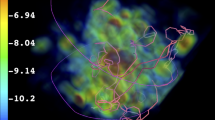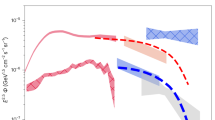Abstract
THE intensity of the diffuse cosmic background radiation for photon energies of 13.6 to ∼ 150eV cannot be measured directly because of absorption by the neutral component of the interstellar medium. In the range 150–300 eV, there is considerable galactic emission within a few hundred parsecs of the Sun which places severe limitations on attempts to measure the intensity and spectrum of the metagalactic background radiation at these energies. An indirect means of estimating the diffuse metagalactic flux of ionising radiation was proposed by Sunyaev1, who studied the interaction of this radiation with neutral hydrogen at the peripheries of galaxies. More locally, the intensity of this radiation within ∼ 1 kpc of the Sun can be probed by studying the ionisation of heavy elements in the interstellar medium2. Here we re-examine Sunyaev's proposal in the context of more detailed studies of the interaction of metagalactic ionising radiation with galactic gas. We give a firm upper limit on the intensity of metagalactic ionising background radiation to which the neutral interstellar medium is exposed, and discuss some important consequences of this result. Our principal conclusion is that further than ∼ 30 kpc from the centre of the Galaxy, self-shielding by H II3,4 is possible only if the flux of ionising radiation is below a certain critical value5–7.
This is a preview of subscription content, access via your institution
Access options
Subscribe to this journal
Receive 51 print issues and online access
$199.00 per year
only $3.90 per issue
Buy this article
- Purchase on Springer Link
- Instant access to full article PDF
Prices may be subject to local taxes which are calculated during checkout
Similar content being viewed by others
References
Sunyaev, R. A., Astrophys. Lett., 3, 33 (1969).
Hill, J. K., and Silk, J., Astrophys. J., 198, 299 (1975).
Felten, J. E., and Bergeron, J., Astrophys. Lett., 4, 155 (1969).
Silk, J., Astr. Astrophys., 12, 421 (1971).
Longair, M., and Sunyaev, R. A., Soviet Phys. Uspekhi, 105, 41 (1971).
Hill, J., Astr. Astrophys., 34, 431 (1974).
Bochkarev, N., and Sunyaev, R. A., Soviet Astrophys. J. (in the press).
Argyle, R., Astrophys. J., 141, 750 (1965).
Davies, R. D., and Gottesman, S. T., Mon. Not. R. astr. Soc., 149, 237 (1970).
Emerson, D. T., Mon. Not. R. astr. Soc., 169, 607 (1974).
Roberts, M., and Whitehurst, R. N., Astrophys. J., 201, 327 (1975).
Zeldovich, Y. B., and Sunyaev, R. A., Soviet Phys. JETP, 56, 2079 (1969).
Einasto, J., Kaasik, A., and Saar, E., Nature, 250, 309 (1974).
Ostriker, J. P., Peebles, P. J. E., and Yahil, A., Astrophys. J. Lett., 193, L1 (1974).
Komberg, B. V., and Novikov, I. D., Pisma Astr. Zh., 1, 3, 3 (1975).
Schmidt, M., Astrophys. J., 176, 289 (1972).
Burbidge, E. M., A. Rev. Astr. Astrophys., 5, 399 (1969).
Author information
Authors and Affiliations
Rights and permissions
About this article
Cite this article
SILK, J., SUNYAEV, R. Ionising flux of cosmic background radiation. Nature 260, 508–509 (1976). https://doi.org/10.1038/260508a0
Received:
Accepted:
Issue Date:
DOI: https://doi.org/10.1038/260508a0
Comments
By submitting a comment you agree to abide by our Terms and Community Guidelines. If you find something abusive or that does not comply with our terms or guidelines please flag it as inappropriate.



